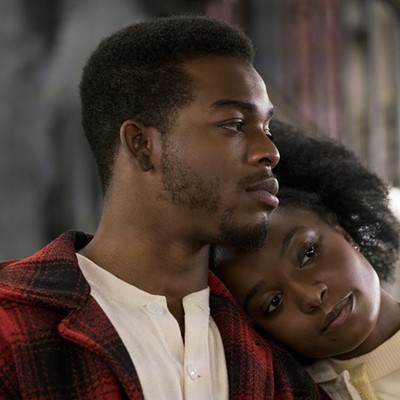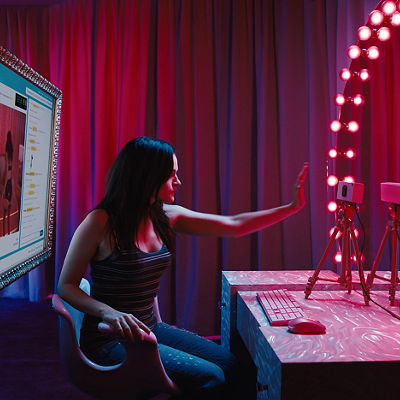
Director José Padilha's long-delayed RoboCop reboot has arrived, and it’s neither an unalloyed (see what I did there?) triumph nor the travesty that partisans of Paul Verhoeven’s subversive Reagan-era classic had feared. At least, and at most, it’s different, taking bold liberties with the original text, as remakes should.
One such change from RoboCop '87 is a decreased emphasis on the henchman and jester of Verhoeven’s picture: ED-209, a dysfunctional, tantrum-prone robot roughly the size of a Ford Expedition. Oh, ED-209s are in the new movie; several of them, in fact. They’re even upgraded, now the size of townhouses. Deployed as menacing “peacekeepers” on the streets of a U.S.-occupied Tehran, they appear to function perfectly as intended, and where’s the fun in that? Their screen time has increased while their presence has diminished.
The original film’s ED-209 was created by live-action animator Phil Tippett, the genius craftsman responsible for the four-legged AT-AT walkers and shaggy, two-legged tauntauns in The Empire Strikes Back, among many other indelible movie machines and creatures. An Oscar-winner for his practical effects work on Return of the Jedi more than 30 years ago, Tippett has kept up with the times, reinventing himself as a digital effects artist and earning subsequent Oscar nominations for Jurassic Park and Verhoeven's other mordant sci-fi satire, Starship Troopers. (That’s the one where puny, highly puncturable humans engage in futile and unnecessarily close combat with the giant alien spiders of Planet Klendathu instead of just nuking them from orbit.)
The visual effects in the new RoboCop are almost all CGI, naturally, including the blandly redesigned ED-209s. But CGI was still years away from being viable in 1986, when Verhoeven's RoboCop was in production. It was made on the cheap, for $13 million. Adjusting for inflation, that’s only about a quarter of the new version’s $100 million-plus price tag. But art thrives on restriction.
Tippett used “go motion,” an update of the frame-by-frame animation techniques that allowed King Kong to scale the Empire State Building half a century earlier, to bring ED-209 to life. What he created isn't merely -- with no disrespect to Peter Weller, Kurtwood Smith, or Miguel Ferrer -- my favorite performance in the film, but one of the most expressive and memorable of all movie robots.
As designed by Craig Davies, ED-209 was more than just a visually arresting creature, pun intended. It was a walking embodiment of the film's satirical payload about rampant privatization and corporate control of public institutions. It looks like the bastard offspring of a muscle car and a Vietnam-era Bell "Huey" helicopter mounted on stilts. (Davies gave each leg four hydraulic struts where only one would be needed, a nod to corporate redundancy.) It growls with the voice of a panther (that’s what foley artist Stephen Flick used) and ambles with the noise and awkwardness of a 2,000-pound toddler. It seems angry that you’ve made it chase you. Its stubby arms end in machine guns instead of hands. It isn’t a law-enforcement tool; it’s a walking antiaircraft emplacement.
That’s OK: In the movie, the cufflink-wearing bloodsuckers of Omni Consumer Products are only deploying it on the crumbling, lawless streets of Detroit as a demo reel for "a guaranteed military sale ... Who cares if it work[s] or not?" (As the new film opens, ED-209s are already in service with the military while their manufacturer, OCP, is lobbying for them and for other armed robots to be deployed on domestic soil.)
On the commentary track of RoboCop’s Criterion Collection DVD, screenwriter Ed Neumeier says ED-209 was meant to represent the U.S. strategy of "urban pacification" in Vietnam brought to the home front. If the robot's Huey-like profile wasn’t enough of a tip-off, the lab-coated technician who turns him on in the film is named Dr. McNamara, after the Vietnam-era secretary of defense.
ED-209 never seems like a mere prop-as-metaphor, though, because he also provides the film's inciting incident. In minute 12 of RoboCop, the 'bot malfunctions during a boardroom demonstration, blowing a junior executive into hamburger. (Producer Jon Davison, who also provided ED’s menacing speaking voice, redid the shots of the poor guy's corpse being pulped by bullet hits three times because Verhoeven didn’t think they were bloody enough. These were among the shots he later had to excise before the MPAA would grant the ultraviolent original an R rating.)
After witnessing a man’s violent death, OCP’s chairman (“The Old Man”) reacts as though he’s just thumbed through a bearish quarterly earnings report. “Dick, I’m very disappointed,” he says. There were hints of a sardonic intelligence at work already, but this is the moment where Verhoeven permanently destabilizes us.
Some of that lingering sense of shock comes from the way Verhoeven films the sequence, and from the Old Man’s callous attitude. But at least as much of it comes the performance Tippett elicited from a puppet not much taller than a beer bottle. A full-size, 7-foot, 300-pound model was also built and filmed, but the shots where ED-209 walks were all of Tippett’s miniature. That one is the actor. It hesitates. It stutters. It flails its three-toed metal foot, searching for its footing. Later in the film, an outgunned RoboCop survives his showdown with the clunky beast because it can't climb stairs -- it tries, slips, and ends up like a beetle on its back, kicking its swollen legs and wailing. Its humiliation was ironic because, in reality, actor Peter Weller couldn't negotiate stairs while bolted into his clunky $600,000 Robo-suit, either.
I remember a photograph from an issue of the long-defunct sci-fi magazine Starlog of Verhoeven standing in front of the full-size ED-209 model on the set of RoboCop, his hands raised above his head, his features contorted into a mask of rage. To this day this is the picture of Verhoeven that comes to mind when I think of him. His next four American films, Total Recall (1990), Basic Instinct (1992), Showgirls (1995), and Starship Troopers (1997), all bolstered his reputation as a European artist who relished picking at America’s puritanical scabs, and this photo seemed to capture that. But he was probably just miming what he wanted the model to do in the scene, a precursor to the way actor Andy Serkis would be motion-captured for his roles in Peter Jackson's Lord of the Rings pictures (and his way-underrated remake of King Kong) a generation later).
Serkis’s performances in those films have an emotional sophistication that actor-unassisted computer animation hasn't yet managed to replicate. But Tippett achieved something close to it when he transformed ED-209 from a scary-looking statue into character. Watching RoboCop these days, you can see it was a penny-pinching production even its in time, which was, least we forget, back when people bought their music on cassette tapes. When ED-209 trundles onscreen to menace our tin-plated hero, it doesn’t look realistic. It just looks alive.





